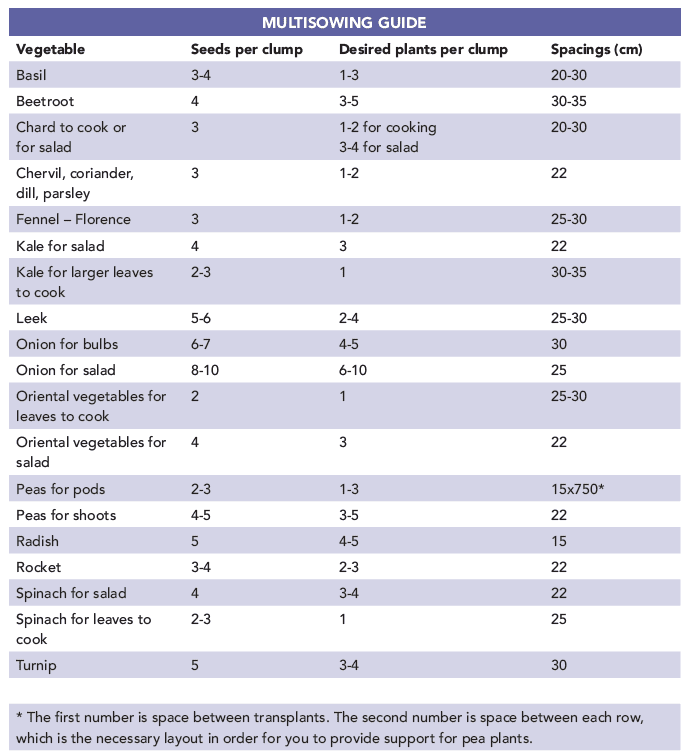Multisowing
What are multisowing benefits and what is multisowing? There are considerable and enticing benefits to sowing two or more seeds concurrently, rather than one seed per module or station, for many vegetables.
This article discusses multi-sowing in module cells, with three to ten seeds per bundle, depending on the vegetable.
You may perform the same thing by direct sowing larger seeds in the ground, using a dibber to create shallow holes for each cluster of seeds; however, for small seeds such as carrots, sowing straight in rows is easier and results in more uniform spacing.
Multisowing Benefits For Translating
There is much to gain. Multisowing is an excellent use of time, space, and materials, and you are rewarded with happier plants that germinate and grow more strongly.
- You can raise more plants in the same area of propagating space.
- You save time because you are transplanting two or more seedlings at once.
- Four-seed modules need three-quarters less compost to propagate the same number of plants.
- There is a companion effect — observe how well plants grow from being with their friends in clumps.
Root Vegetables That Can Be Multi Sown
The word ‘root vegetables’ is frequently misused, as it is a descriptive term rather than a botanical one.
I dislike hearing it used to describe rotation, which is the practice of growing vegetables from the same plant family in a different location each year.
Root vegetables come in a variety of varieties and grow in two distinct ways. Multisowing is more effective with the second group.
1: From direct seeding, parsnips and carrots produce unforked taproots, which is the edible portion.
They can still be grown as transplants, and carrots can be grown in clumps, although they tend to grow with forks, making them less attractive at harvest and more difficult to clean.
Salsify, scorzonera, and Hamburg parsley all fall under the same category.
2: All other root vegetables swell wonderfully the following transplantation, and the portion we eat is essentially a swollen stem or bulb that sits above the plant’s root system (see the photo of celeriac).
The act of transplanting disrupts a taproot and results in more fibrous roots below the soil, but this does not affect the growth of the bulbs.
Celeriac and swede are both root crops that can be transplanted but perform best when grown as singles. They require more area to mature than, say, beetroot and onions.
Beetroot
This is a timeless classic. Since 1987, I’ve grown multi-sown beetroot and have always appreciated the additional harvest and ease of producing.
The most productive number in a cluster is four, however, achieving this is not clear. Beetroot seeds are clusters in and of themselves! From a botanical standpoint, these seeds are fruits.
One seed may produce up to four seedlings, whereas some beetroot seeds produce just one beetroot or may never germinate.
Three seeds in a module, trimmed to four seedlings, is my ideal number. Three seeds mean that after thinning, each module should contain the appropriate amount of four plants.
Florence Fennel
Fennel transplants easily and thrives in clumps of two to three plants. However, I generally transplant single fennel plants, even pricked-out seedlings, because I prefer larger bulbs.
If you prefer smaller bulbs in greater abundance, multisow three seeds thinned to two plants.
Onions For Bulbs
This is another typical multisowing veggie. Seedlings thrive in their partners’ company and grow together in a supportive network of thick leaves.
The yield is comprised of numerous medium-sized bulbs and a few little ones, as compared to fewer large onions when grown as singles.
A caveat is onion mildew caused by close planting – you’d see a grey mold on the leaves in early summer’s moist weather.
This is unlikely to be a problem in dry locations, but if you are concerned, sow ‘Flylander‘ or ‘Santero’ (both F1), which are resistant to Peronospora destructor – a monstrous name for a monstrous disease!
By mid-May, it is beneficial to thin clumps — we pluck the tiniest plants for eating as spring onions.
Although I prefer four onions per clump, this method works equally well with more or less. All onion plants, regardless of their name, can be consumed at any stage.
Onions thrive in cool environments, thus planting them is permissible even if night frosts persist.
They build a robust root system, which fuels incredible growth throughout the long days of late spring. You can almost see them develop, and I adore their upright leaves with their proud gloss.
Although you can multisow onion sets, it is just as simple and just as effective to plant them densely, with as little as 7.5cm/3in between each onion.
Vegetables with a wider spacing, such as peas and potatoes In August and September, you can multisow turnips and radish to establish a late crop after harvesting any summer vegetables.
Or, if space allows, transplant them amongst any vegetables that are nearing completion.
Multisowing Guide

The figures in the chart above correspond to medium-sized plants with a high yield.
The number of plants in a clump is entirely up to you, depending on the size of the plant required and how you prefer to pick the leaves.
The first column indicates the recommended number of seeds to sow per module.
These figures are greater than those in the second column of the same row to account for seeds that do not germinate. Additionally, certain species develop slowly and are best removed.
The second column indicates the maximum number of plants per clump that can develop to a useful and harvestable size in my experience.
Beetroot and chard are outliers due to their clustered seeds, which frequently germinate many seedlings.
The spacings indicated in the third column are not rigid and are merely suggestions based on ‘typical’ harvest sizes.


























